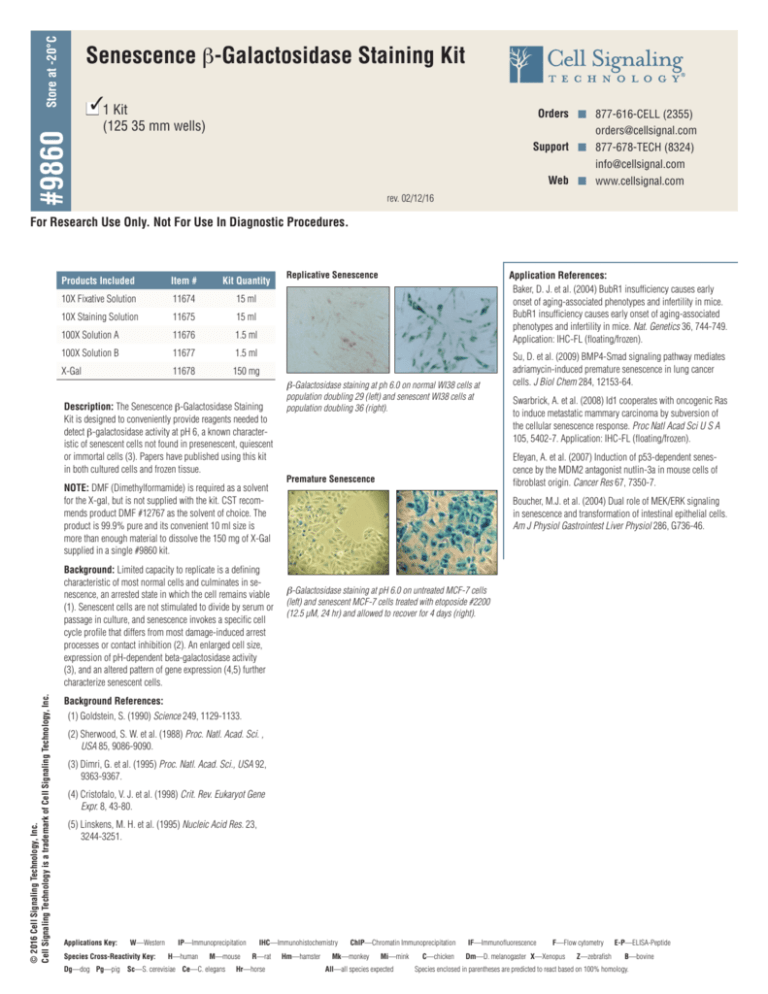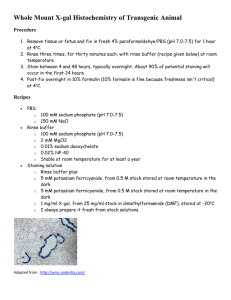Senescence β-Galactosidase Staining Kit
advertisement

Store at -20°C Senescence β-Galactosidase Staining Kit #9860 31 Kit n Orders n 877-616-CELL (2355) orders@cellsignal.com Support n 877-678-TECH (8324) info@cellsignal.com Web n www.cellsignal.com (125 35 mm wells) rev. 02/12/16 For Research Use Only. Not For Use In Diagnostic Procedures. Products Included Item # Kit Quantity 10X Fixative Solution 11674 15 ml 10X Staining Solution 11675 15 ml 100X Solution A 11676 1.5 ml 100X Solution B 11677 1.5 ml X-Gal 11678 150 mg Application References: Baker, D. J. et al. (2004) BubR1 insufficiency causes early onset of aging-associated phenotypes and infertility in mice. BubR1 insufficiency causes early onset of aging-associated phenotypes and infertility in mice. Nat. Genetics 36, 744-749. Application: IHC-FL (floating/frozen). Replicative Senescence β-Galactosidase staining at ph 6.0 on normal WI38 cells at Description: The Senescence β-Galactosidase Staining Kit is designed to conveniently provide reagents needed to detect β-galactosidase activity at pH 6, a known characteristic of senescent cells not found in presenescent, quiescent or immortal cells (3). Papers have published using this kit in both cultured cells and frozen tissue. NOTE: DMF (Dimethylformamide) is required as a solvent for the X-gal, but is not supplied with the kit. CST recommends product DMF #12767 as the solvent of choice. The product is 99.9% pure and its convenient 10 ml size is more than enough material to dissolve the 150 mg of X-Gal supplied in a single #9860 kit. © 2016 Cell Signaling Technology, Inc. Cell Signaling Technology is a trademark of Cell Signaling Technology, Inc. Background: Limited capacity to replicate is a defining characteristic of most normal cells and culminates in senescence, an arrested state in which the cell remains viable (1). Senescent cells are not stimulated to divide by serum or passage in culture, and senescence invokes a specific cell cycle profile that differs from most damage-induced arrest processes or contact inhibition (2). An enlarged cell size, expression of pH-dependent beta-galactosidase activity (3), and an altered pattern of gene expression (4,5) further characterize senescent cells. population doubling 29 (left) and senescent WI38 cells at population doubling 36 (right). S u, D. et al. (2009) BMP4-Smad signaling pathway mediates adriamycin-induced premature senescence in lung cancer cells. J Biol Chem 284, 12153-64. Swarbrick, A. et al. (2008) Id1 cooperates with oncogenic Ras to induce metastatic mammary carcinoma by subversion of the cellular senescence response. Proc Natl Acad Sci U S A 105, 5402-7. Application: IHC-FL (floating/frozen). E feyan, A. et al. (2007) Induction of p53-dependent senescence by the MDM2 antagonist nutlin-3a in mouse cells of fibroblast origin. Cancer Res 67, 7350-7. Premature Senescence Boucher, M.J. et al. (2004) Dual role of MEK/ERK signaling in senescence and transformation of intestinal epithelial cells. Am J Physiol Gastrointest Liver Physiol 286, G736-46. b-Galactosidase staining at pH 6.0 on untreated MCF-7 cells (left) and senescent MCF-7 cells treated with etoposide #2200 (12.5 μM, 24 hr) and allowed to recover for 4 days (right). Background References: (1) Goldstein, S. (1990) Science 249, 1129-1133. (2) Sherwood, S. W. et al. (1988) Proc. Natl. Acad. Sci. , USA 85, 9086-9090. (3) Dimri, G. et al. (1995) Proc. Natl. Acad. Sci., USA 92, 9363-9367. (4) Cristofalo, V. J. et al. (1998) Crit. Rev. Eukaryot Gene Expr. 8, 43-80. (5) Linskens, M. H. et al. (1995) Nucleic Acid Res. 23, 3244-3251. Applications Key: W—Western Species Cross-Reactivity Key: IP—Immunoprecipitation H—human M—mouse Dg—dog Pg—pig Sc—S. cerevisiae Ce—C. elegans IHC—Immunohistochemistry R—rat Hr—horse Hm—hamster ChIP—Chromatin Immunoprecipitation Mk—monkey Mi—mink All—all species expected C—chicken IF—Immunofluorescence F—Flow cytometry Dm—D. melanogaster X—Xenopus Z—zebrafish E-P—ELISA-Peptide B—bovine Species enclosed in parentheses are predicted to react based on 100% homology. #9860 Senescence β-Galactosidase Cell Staining Protocol A Solutions and Reagents CProcedure: Reagents provided are sufficient to stain 125 35 mm wells. 1.Remove growth media from the cells. 2.Rinse the plate one time with 1X PBS (2 ml or a 35 mm well plate, or match volume of media) 3.Add 1 ml of 1X Fixative Solution to each 35 mm well. Allow cells to fix for 10-15 min at room temperature. 4.Rinse the plate two times with 1X PBS 5.Add 1 ml of the β-Galactosidase Staining Solution to each 35 mm well (see Solution Preparation Step 5). Important: Seal plate with parafilm to prevent evaporation. Evaporation can cause crystals to form. 6.Incubate the plate at 37°C at least overnight in a dry incubator (no CO2). Note: The presence of CO2 can cause changes to the pH which may affect staining results. 7.While the β-galactosidase is still on the plate, check the cells under a microscope (200X total magnification) for the development of blue color. 8.For long-term storage of the plates, remove the β-Galactosidase staining solution and overlay the cells with 70% glycerol. Store at 4°C. Supplied Reagents 1. 10X Fixative Solution #11674 2. 10X Staining Solution #11675 3. 100X Solution A #11676 4. 100X Solution B #11677 5. X-Gal #11678 Additional Reagents (Not Supplied) 1. 1X PBS 2. DMF (Dimethylformamide) #12767 3. Polypropylene tubes 4. 37°C dry incubator (No CO2) 5. Phase contrast or light microscope 6. 70% glycerol (optional) B Solution Preparation NOTE: All solutions should be prepared just prior to use. Volumes are for one 35 mm well of a 6-well plate. Volumes in the procedure should be approximately half that of the tissue culture media. (e.g. 1 ml for 35 mm well/plates containing 2 ml of media, 2.5 ml for 60 mm plates containing 5 ml of media, and 5 ml for 100 mm plates containing 10 ml of media). 1. PBS: Prepare at least 6 ml 1X PBS per 35 mm well 2. Fixative Solution: Dilute the 10X Fixative Solution to a 1X solution with distilled water. You will need 1 ml of the 1X solution per 35 mm well. 3. Staining Solution: Redissolve the 10X Staining Solution by heating to 37°C with agitation. Dilute the 10X staining solution to a 1X solution with distilled water. You will need 930 ul of the 1X Staining Solution per 35 mm well. 4. X-Gal: IMPORTANT: Always use polypropylene plastic or glass to make and store X-gal. Do not use polystyrene. Dissolve 20 mg of X-gal in 1 ml DMF to prepare a 20 mg/ml stock solution. Excess X-gal solution can be stored in -20°C in a light resistant container for up to one month. 5. β-Galactosidase Staining Solution: For each 35 mm well to be stained, combine the following in a polypropylene container: a. 930 µl 1X Staining Solution (See step 3) b. 10 µl 100X Solution A c. 10 µl 100X Solution B d. 50 µl 20mg/ml X-gal stock solution (see Step 4) © 2011 Cell Signaling Technology, Inc. IMPORTANT: Due to variations in water pH, please be sure that the β-Galactosidase Staining Solution has a final pH of 6.0 (A pH 5.9-6.1 is acceptable). pH differences can affect staining: A low pH can result in false positives and high pH can result in false negatives. If necessary, use HCl or NaOH to lower or raise pH, respectively. Orders n 877-616-CELL (2355) orders@cellsignal.com Support n 877-678-TECH (8324) info@cellsignal.com Web n www.cellsignal.com





